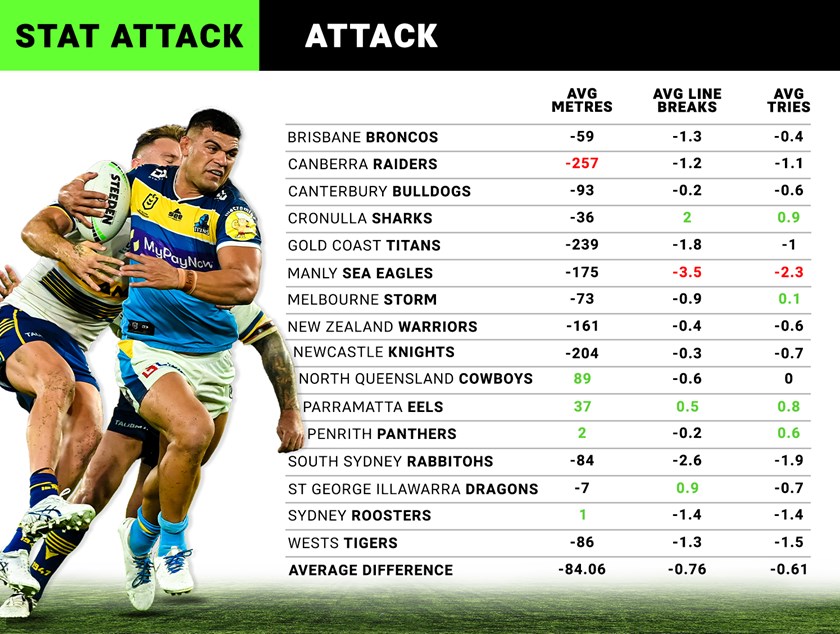
Seven rounds into the new NRL season and its adjusted rules, some trends are starting to emerge – but one vastly improved club is swimming against the tide.
There was one significant gameplay rule change brought in this year, with the controversial six-again restarts no longer awarded to a team defending inside its own 40 metres, with a penalty awarded for offside and ruck infringement plays instead.
Previously, a team with the ascendency could hammer a rival team in its own end with effectively no penalty – a set restart on play one offered no reward to the team infringed against.
Removing this option for a dominant team has evened the ledger a little, meaning more footy is played between the 20-metre lines rather than inside them and there has been a return to some of the arm wrestle.
It has also meant a team with a weaker roster can still compete with a stronger side provided they came with a good game plan and plenty of discipline; while there has still been the occasional blowout when a top side gets on a roll, these have been the exception rather than the norm so far this year.
Attack – points and line breaks reduced
After seven rounds, teams on average are scoring 0.61 fewer tries per game compared to the regular season last year. Only four teams are averaging better than last year and three of those were among the top sides last year, with the Storm (+0.1), Panthers (+0.6) and Eels (+0.8) scoring more tries than last year.
But the biggest improver has been Cronulla (+0.9) under new coach Craig Fitzgibbon, with star signing Nicho Hynes and breakout centre Siosifa Talakai among the best players in the competition through seven rounds.

The biggest drop-off has been at Manly, who are averaging 2.3 fewer tries per game compared to their Turbo-charged 2021 campaign. South Sydney (-1.9) have the next-biggest regression as they've struggled to adapt to the loss of Adam Reynolds.
Wests Tigers (-1.5), Roosters (-1.4), Raiders (-1.1) and Titans (-1.0) are all averaging at least one try per game worse in attack than in 2021 so far.
The difference is slightly more stark when it comes to line breaks, with Cronulla (+2.0) easily the biggest improvers and just two other sides going better than they did last year in the Dragons (+0.9) and Eels (+0.5).
Manly again have seen the biggest drop-off, making 3.5 fewer line breaks every game than last year. Souths (-2.6) and Gold Coast (-1.8) have also dropped off sharply.
Talakai's demolition job
The yardage game also tells its own story. Teams, on average, are making 84 metres less per game this year and while the Eels and Panthers have again narrowly improved, the one big outlier is the Cowboys at +89 metres per match.
Manly are again among the biggest drop-offs, with their -175 metres per game the fourth-worst result compared to 2021. The Knights have lost 204 metres per game, the Titans 239 and the Raiders a massive 257 per match compared to last season.
Cronulla's -36 metres per game is the sixth-best comparison rate and comfortably better than the NRL average of -84.
Defence – tackles and effective rate down
Teams on average are making slightly fewer tackles than last year, and the effective tackle rate has slipped fractionally, but both differences are negligible.
Overall teams are making 10.5 fewer tackles per game, which isn't much when teams average just over 320 tackles made per match. Effective rates are effectively level, down just 0.1%.
The more interesting tidbit is just how much certain teams have gone up or down.
The Dragons are making a whopping 63 fewer tackles per game. Last year they averaged an NRL-high 365 tackles per match, while so far this year their 302 tackles per game is less than anyone bar Melbourne. Their NRL-high 248 missed tackles could be a factor here.
The Cowboys (-41) are also holding enough possession to be making far fewer tackles than last year while the Eels (-30), Storm and Panthers (both -23) are ahead of the curve.
The Bunnies are probably missing Reynolds' kicking game here too, with the biggest increase in made tackles of any side (+27), while Brisbane (+15) and, counterintuitively, Cronulla (+12) have gone up the next most.
As you'd expect, defensive penalties conceded are up for all sides given penalties have replaced six-again calls inside 40 metres with an average of 1.7 more penalties per team per match.
The biggest jumps in penalties conceded have gone to the Storm (+3.66) and Sharks (+2.84). Ruck infringements are, expectedly, down across the board with the Storm (-1.94) having dropped the most.
General play – play time and play-the-balls show little movement
The overall increase in defensive penalties per game of 3.4 per match is almost double the decrease in ruck infringements of 1.8 per game. However neither this – nor the extra time for defences to re-set – has significantly altered the amount of ball-in-play time nor the in-game ruck speed.
The steady ball-in-play figure (we're averaging about half a second more so far this season) can be explained by the decrease in total tries, which has cancelled out the dead time of a few more penalties with less dead time for tries scored.
Play-the-balls are a touch slower this year, which is to be expected – but only 0.11 seconds per ruck.
In a one-off instance, a fast play-the-ball can be crucial to a rolling attacking set to get the defence backpedalling.
In case you needed more reasons to trade in Talakai
However, across the course of 80 minutes, there's often little correlation between PTB speed and success, with losing teams frequently boasting a faster average PTB in a match than the winning side.
For example in round seven the Titans had a much faster average PTB than the Cowboys, the Knights a much faster PTB than the Eels, the Raiders likewise against the Panthers and even the Warriors had a much faster average PTB speed than the Storm yet all lost heavily.
So while the 0.11 second slowdown per ruck can add up over 600-plus tackles in 80 minutes, the slight increases and decreases per club have shown no correlation to success so far this year.
